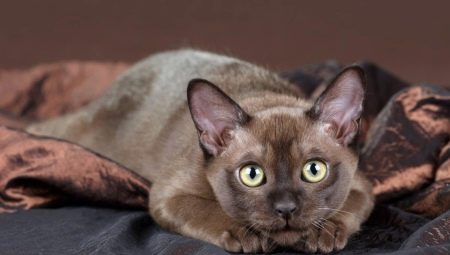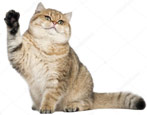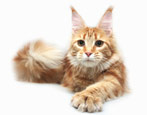For many people, brown and all its shades are a symbol of calm and coziness, as well as warmth. This color have coffee, chocolate, autumn leaves, hot tea. Few people will not feel aroma and taste at the words: a cup of coffee and chocolate cake. Few people will not be delighted with such a combination. And what other pet would be so identified with coziness and comfort, if not a cat. And there are such cats, and various breeds. They are very beautiful, some of them are smooth-haired, and some look like fluffy chocolate.


Features
An interesting fact is that genetically chocolate color belongs to the black group. Its recessive gene determines it; therefore, it is not so easy to derive such a color as a dominant color.
There is a special calculator that allows you to determine the likelihood of a chocolate kitten in the litter. To do this, you need to know not only the color of the parents, but also their genotype. In accordance with Mendel’s law, you can calculate the percentage probability that it is from these parents that you can get a dark brown kitten.
The calculator also calculates the probability of the appearance of harlequin, bicolor, tortoise or marble coat color of the future kitten.



Literate breeders are well aware of the set of genes of their cats, which allows them to achieve unusual colors in feline cubs. Despite the fact that there are not so many genes that are directly responsible for the color of the animal, there are a huge number of combinations. Two genes are involved in the formation of the color of each kitten - from the side of the mother cat and father. It is their combination that gives interesting and unusual options for coloring animals.
Fully chocolate is a York cat. It was bred in the USA in a rather interesting way. An ordinary cat lover for a long time chose kittens of this color from the Persian and Siamese representatives. So this breed appeared, which in 1983 was officially recognized. These are energetic, friendly cats with uniformly colored brown and lilac hair. No spots, stripes, marks are unacceptable.


It is impossible to buy representatives of the breed in Russia, there are no nurseries. The purchase of a kitten abroad is a very expensive undertaking; the price for a kitten is at least 100 thousand rubles. Nevertheless, the breed is incredibly popular both in our country and in Europe and America.
Popular breeds
Consider a relatively inexpensive cat breed, which also happens to be "chocolate" in color.
Abyssinian cats are smart, medium-sized, shorthair animals. The color of the Abyssinians is dark brown, approaching black. Through the ridge line passes a strip having a reddish-brown hue. The overall color varies from copper-red to red-brown. Ticking can be double, even triple, which means that each hair coat has two or three shades. As for the brown scale of the Abyssinians, it includes a wild, bay and beige color.

Havana cats got their name in honor of the corresponding shade of Havana cigars. And all because the color of the very first representatives of the breed was tobacco, dark brown. Havana cats are short-haired, uniform color. Initially, the breed was called "bay brown", since there were doubts about the truth of its British origin, but now they have disappeared. The breed is again called Havana, which suits it much more.


Chocolate Persian cats have excellent build, wide chest. Their bodies are stocky, strong. The head is proportional to the body. The nose is slightly flattened, like in Persian cats of all colors, the coat is long and soft. The brown color gamut includes all shades, but other tones are excluded in this situation. The undercoat can be painted in gray, have iridescent overflows. The beauty of a cat is enhanced by the eyes, which can be orange (amber) or emerald green.
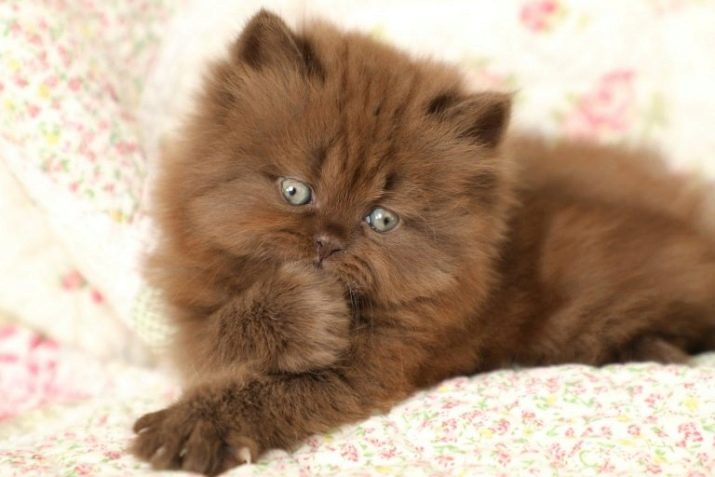
Chocolate exotics (in professional language called "force point") - a breed of American origin. Chocolate color can be either uniform or marbled. Shades of brown range from coffee to tree bark tones. Exotics are short-haired, attractive due to an interesting, original muzzle and round big eyes. Their charm strengthens the magnificent tail. Their physique is average.
The character is specific, they need a special approach and increased attention - then the owner is guaranteed love and affection of the pet.

Burmese cats are strong and muscular. The breed originated in Burma, the year of breeding 1934. For brevity, they are called "burmese". They have yellow eyes, brown coat, that is, dark brown.
Burmese cats are very kind, sociable and find great contact with children, adults, even dogs.
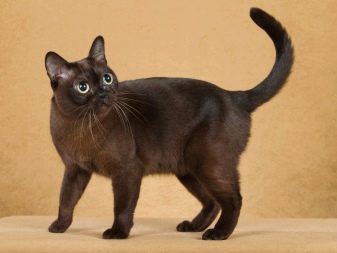

Devon Rex - alien cats. Larger-eared, narrow-mouthed, with almond-shaped eyes. Devon Rex have a slender body. The appearance of these cats is as unusual as possible. In addition to the original proportions of the body, they also have curly hair. Deriving the breed is not easy, since in this situation the principle of backcrossing applies, otherwise the sign of curl will disappear.
Devon Rexes are sociable and friendly, cheerful, curious and spontaneous. Very attached to the owners.

British cats of chocolate color with blue eyes are unusually beautiful. They are plush in appearance and to the touch, and due to the color of their wool they look like little cubs. The British are short-haired, but their coat is unusually thick. Chocolate British cats have a medium body build.The color "chocolate" on the British is very deep, rich, evenly distributed. Sometimes it can have a brown tint. The uniformity of the color is achieved for a long time - from a year to a year and a half. Chocolate British cat looks very “purebred”.


Scottish fold cats can have all shades of brown. Not necessarily uniform, it can be tiger, marble, ticked or spotted, and the color “tabby” is also acceptable. Scottish cats have white spots. Such cats are called harlequins or bicolors. Harlequin is predominantly white, but there are large chocolate-colored spots on the trunk and legs. In bicolors, on the contrary, brown prevails, small spots of white color are present on the paws or chest.
The breed has an extraordinary shape of the ears - they hang above the head, directly adjacent to it. The character of the Scots is gentle and kind. The hair is mostly short, but on the tail it is quite magnificent.


How to choose?
You need to choose a chocolate cat very carefully. It is necessary to acquire kittens exclusively in trusted nurseries, with breeders who have an excellent reputation. Especially carefully you need to choose kittens whose color is not purely chocolate, but bicolor or spotted. Perhaps they lack the “chocolate” gene, that is, the offspring will not have the appropriate color. It is imperative to look at the kitten’s parents: both of them must have a “chocolate” color, only then it will be clear that the kitten has this gene.
The American kittens registration system is characterized by complete confidence in the breeder. Therefore, if the breeder indicates “chocolate” in the color of the cat, then it will be registered.
So even if the animal received an assessment on the American site, this does not mean at all that the color is true.

In addition, you need to consider that the prices of chocolate-colored kittens do not depend on their breed. For example, a show-british kitten costs between $ 400 and $ 1,000. The cost of a Scottish fold kitten ranges from 3 to 25 thousand rubles. Abyssinians will cost you from 10 to 25 thousand rubles, depending on the class of the animal. Show-class Devon-Rex costs about 30,000 rubles, a brid-class is cheaper. Persian kittens are more budgetary, their price varies from 3 to 10 thousand, but the Burmese breed is not so cheap - one kitten costs from 15 to 20 thousand rubles.


The subtleties of care
To care for a cat with a chocolate color, you need the same way as for its relative of any other color. In this situation, more attention should be paid to the cat breed, but not the color.
Persian cats must be looked after as required by the breed - carefully and often comb out, monitor the cleanliness of the muzzle, teeth and ears. For the Persians, you need a slicker, as this is a very fluffy breed.
If the cat likes to walk, she needs to at least wash her paws after walking, and if the coat is long, then bathe. Therefore, to make sure that the pet is accustomed to water and not be afraid of it is the master's business.
A representative of any breed every 6 months must be taken for a routine examination to the veterinarian. Of course, vaccinations, antiparasitic measures should be carried out on schedule.
All cats need movement, even the most pampered.

If your pet is inactive, take care of proper, balanced nutrition. The same applies to castrated males - in order to avoid obesity, the cat must be properly fed. In general, feeding should be carried out in strict accordance with the recommendations for the breeds.
There are few cats who like to stay alone for a long time. Most of them need a society, or at least the presence of a host. Leaving them alone for a long time, the owner runs the risk of at least returning to the mess, and at the very least - the cat will “punish” him, arranging a real tararam for his return. After all, one should not forget that most cats are very wayward, even the shrews, they know how to take offense and take revenge. You should not offend your pet, since you started it.
You can take a closer look at the chocolate fold kittens in the next video.
